The Need for PRE-hab Before Surgery
The need for physical therapy or rehab after surgery is well-recognized in human and veterinary medicine. Rehab drastically decreases pain and recovery time and helps ensure proper healing. The need for PREhab, however, is sometimes overlooked.
While rehab is therapy directed at healing after the operation, prehab is the conditioning and strengthening of the body in preparation for surgery. Rehab is a REactive means of therapy and prehab is a PROactive means of therapy. Patients that participate in a prehab program prior to surgery have a safer surgery, easier recovery and a decreased length of time from operation to return to exercise.
Improving Surgical Candidacy
Prehab prior to surgery is aimed first at ensuring the animal is a good surgical candidate, able to withstand the physiological stress of the procedure. Many injuries cause decreased ability to exercise. While waiting for surgery, patients can experience a rapid deterioration of physical condition. They quickly lose muscle strength and tone and lose cardiac and respiratory fitness. They may gain weight. All of a sudden, they are no longer ideal surgical candidates and have an increased risk of surgical or anesthetic complications. A prehab program can evaluate and adjust the nutritional needs of the animal in preparation for surgery and focuses on a safe exercise plan to maintain fitness without stressing the injury.
Preparing the Owner
Another benefit of prehab is that it helps prepare the owner for the surgery and recovery. It can be quite scary going into an orthopedic surgery with your pet, but prehab can help ready the owner for the nursing care that will be required in the recovery days. Tips and tricks on how to help your recovering animal get in and out of the car for the trip home, eat, drink, stay quiet and get up to go to the bathroom can go a long way in helping to decrease post-op stress. We also offer post-operative video calls with owners to help walk them through treatments and exercises that may have been prescribed after surgery.
Preparing the Environment
An important part of surgical preparation includes readying the animal’s environment for recovery. A rehabilitation specialist will be able to guide the owner on preparations that need to be made. This may include installing ramps to ease trips in and out of the house. It may include covering slippery floors with carpet or other non-slip surface. If cage rest is necessary, finding an appropriately sized cage or small room and acclimating the animal to this space may be helpful. Large animals may benefit from periodic cold hosing, icing and bandaging, not only for their anti-inflammatory effects, but also to help them adjust to these crucial post-op treatments. Attempts to kick a bandage off of an immediately post-op limb could be catastrophic. A prehab program will also help the horse become familiarized and comfortable with the modalities available, potentially including vibration plate therapy, laser therapy, therapeutic ultrasound, shockwave, underwater treadmill, etc.
Aiding the Recovery
Surgical prehab is also aimed at easing the animal’s own recovery after surgery. The goal is to improve muscle strength and tone to help the patient withstand the inactivity and inevitable step backward after surgery. The object is for them to take two steps forward, so that when they take one step back, they are still ahead!
Some animals may not be able to bear weight on an injured limb immediately after surgery. Strengthening of the core and compensatory limbs prior to the operation can help ease this transition. On the other hand, some animals may have been three-legged for months prior to surgery and may have lost range of motion and strength in the injured limb. Spending time improving musculature and range of motion on the non-weight bearing limb prior to surgery, will help the animal use the limb more comfortably after the operation. Improving proprioception and balance can decrease the chance of a fall-related post-operative set back, as well.
Finding Your Rehab Specialists
Finally, scoping out a rehab facility prior to surgery is essential so that your animal can hit the ground running with no time wasted. Small animals ideally are seen by a rehab therapist in the first week after discharge. Horses often trailer directly to a rehab center after discharge from the hospital. Making these reservations prior to surgery will help ensure your animal gets the care they need, when they need it!
